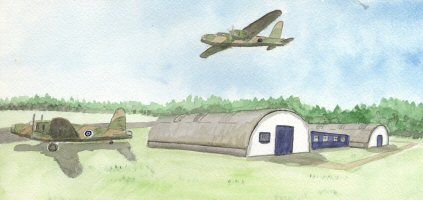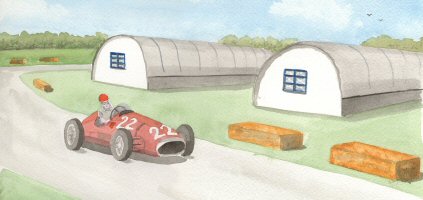SILVERSTONE RACE TRACK
Silverstone is a small village located South of Northampton town in the heart of Northamptonshire, England. Now famous for its world renowned motor racing circuit, Silverstones rise to fame began during World War II when it was one of hundreds of airfields built to defend our shores and also to launch bomber attacks onto mainland Europe.
Built in 1943, Silverstone Airfield became the base of the Royal Air Forces 17th Operational Training Unit. Its prime function was to instruct aircrews in the flying of Vickers Wellington twin-engined bombers. Obviously, such large craft could not operate on small grass airfields and Silverstone was therefore equipped with two Bitumen runways, one 882 metres long and the other more than 1000 metres. They were set at 40° to each other allowing landings and take offs to be vectored at 020°, 200°, 060° and 240°. Like so many wartime airfields, Silverstone was decommissioned at the end of the war.

In 1946, it is alleged that a Silverstone resident, Maurice Geoghegan, was looking for somewhere to drive his new Frazer-Nash sports car. He couldn't properly put it through its paces on regular roads. He was aware of the large disused airfield nearby and took his car there for a spin. He was absolutely delighted to discover access from the runways to a perimeter road and back again, and soon found he had a ready-made circuit. So pleased was he at being able to test his car to the full that he told a few of his friends and in 1947 a small group of 12 cars held an illegal race. So the story goes, that race became known as "The Mutton Grand Prix" as a result of Geoghegans collision with a wandering sheep. Whether or not there was a post-race barbecue was not documented.

It was around this time that the RAC (Royal Automobile Club) were scouring the country for a venue for the British round of the new Formula One Grand Prix series. It was as a result of the reports submitted regarding the illegal "Mutton GP" that they heard about the antics near Silverstone, looked at the 'circuit', contacted the Air Ministry and subsequently arranged to lease the aerodrome for race purposes. By utilising the two runways and part of the perimeter road a circuit of 3.67 miles was created. That first Grand Prix was won by Giuseppe Farino driving an Alfa-Romeo.
Though used for the first GP, this layout proved unsatisfactory because it caused cars to be hurtling towards the centre cross-over point, head-on, at break-neck speed. For subsequent races the circuit was changed to use more of the perimeter road and only one runway reducing the overall circuit length to 3 miles. Since the first Grand Prix in 1950, only 16 of the annual races have not been staged at Silverstone. It is known as the home of the British Grand Prix .... and I hope it remains so for a long time to come.
As a footnote, it is appropriate that Silverstone began its days as an airfield because it is claimed that during race weekend it becomes the busiest airport in the country in terms of frequency of landings and take-offs.

